Polar bears are always considered carnivorous. Their main diet consists of bearded and ringed seals. They also eat berries, eggs, and algae in the summer when their favorite prey is unavailable. Scientists use a special term for polar bears – “hypercarnivores.”
So, we found that most of the people really need clarification here. Are polar bears omnivores, herbivores, or carnivores? To know the facts, we need to get into the topic. So, just read on to find the gory details about what polar bears eat. We will also discover what are the factors that affect their diet and how their diet changes from year to year.
Is a Polar Bear Omnivore, Herbivore or Carnivore?
Most of the bears found in “Bears Family” do not eat meat much. And so, they all are omnivores. Their diet consists of both plants and animals. But, confusion comes into our minds when we think about polar bears. These bear species live in Arctic tundra regions. Plants and vegetation in the Arctic are sometimes zero, sometimes fewer, and if they appear in summer, they are far between.
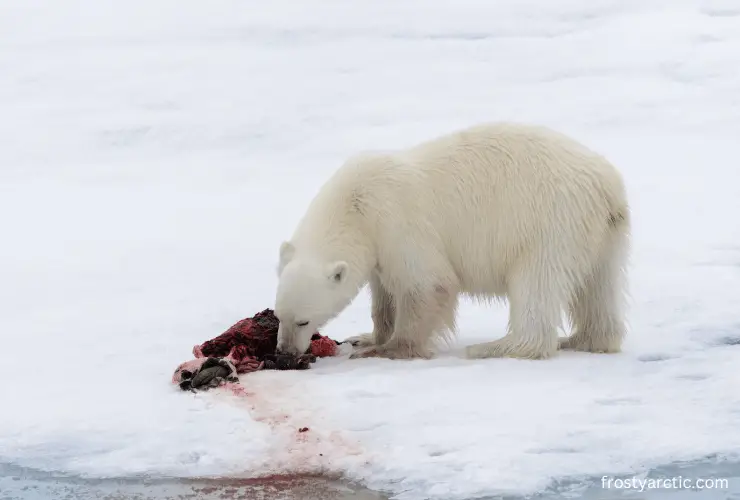
According to the report of the National Wildlife Federation, polar bears are exclusively carnivorous. They are carnivores because their preferred and specialized diet is meat. In simple words, “polar bears are meat eaters”. In fact, Arctic bears are different because they are not like other species of the bear family.
*Important Note:
“Let’s see briefly what are omnivores, carnivores, and herbivores:
- Omnivores: Animals that eat plants and animals to survive are known as omnivores.
- Carnivores: Animals that eat animals (meat-eaters) are known as carnivores.
- Herbivore: Animals and organisms that eat plants to survive are known as herbivores.”
According to various studies, most polar bears are omnivores because they eat not just meat but also plants, vegetables, and fruits. However, polar bears are carnivores. Again, this is due to their meaty diet.
Huge Canines
Is there any adaptation that tells them they are genuinely carnivores and not herbivores or omnivores? Yes. There is one physical adaptation of polar bears that tells them they are different from other bears and they are carnivores. We are talking about the teeth of polar bears!
Yeah, their teeth reflect their eating behavior. They have huge canines. And, they have relatively smaller molars than other bears that fall under the category of omnivores. This type of physical adaptation clearly shows that they are born as carnivores.
Why is the Polar Bear in Carnivora?
So, why do we classify polar bears in Carnivora order? Although they eat meat, they still fall under the broader category of carnivorous animals. All because of their diet and certain anatomical features common to carnivores. According to the study by the Arctic WWF organization, we found the following reasons why polar bears fall in Carnivora order. ~ Source
- Evolutionary History: The polar bear is descended from a common ancestor within the Carnivora order. Its ancestors adapted to the Arctic environment with time. So, it led to the emergence of the polar bear as a distinct species and falls in the Carnivora order.
- Anatomical features: Polar bears have typical carnivore traits. For example, they have sharp claws, well-developed canines, and a carnivorous dentition. These features are indicative of their predatory nature.
- Shared features: They share various characteristics with other carnivorous species within the Carnivora order. You’ll find many shared features in the bear family members (Ursidae) and other carnivores like cats, dogs, and seals.
- Genetic relatedness: Molecular studies and genetic analysis have confirmed that the polar bear is part of the Carnivora order.
Some experts say that “polar bears are hypercarnivores.” What are hypercarnivores? According to these experts, it’s a special term that means “animals that eat more than 70 percent meat. They include meat in three-quarters of their diet throughout their lives. So, they are called hypercarnivores.”
Are Polar Bears True Omnivores?
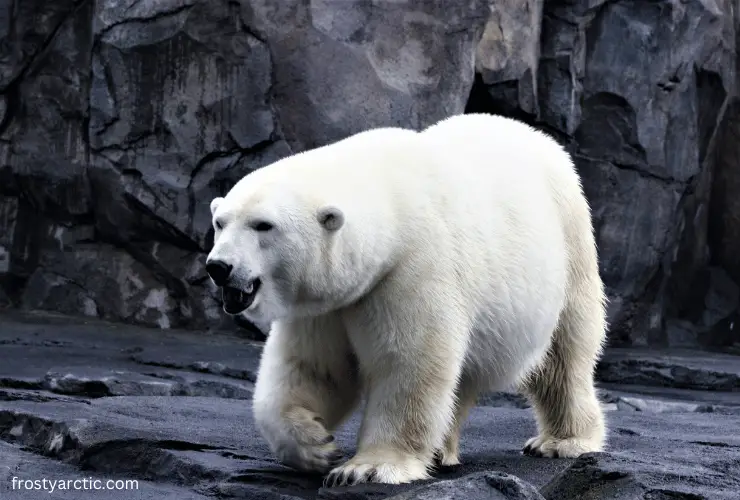
No. According to the research of the National Geographic organization, polar bears are not true omnivores. Polar bears are omnivores in the sense they eat plants and animals.
But, they do also eat other predators and their prey. So, polar bears are somehow omnivores but not true omnivores. Their main diet is meat and only meat.
Are There Any Species of Bears that are Strictly Herbivorous or Carnivorous?
Yes, only two species of the Bears family are strictly known as herbivorous or carnivorous. These are: ~ Source
- Panda Bears – Herbivorous
- Polar Bears – Carnivorous
So, the above-mentioned two bear species are strictly herbivorous or carnivorous. This is because Giant Pandas only and only eat bamboo. And, polar bears only and only eat meat and bigger animals. Also, both have fixed and strict diet plans, while the other species of bears have flexible diet plans.
It is said that American Black Bears are also listed as herbivorous. They eat berries, nuts, fruits, and plant matter. They eat all this secondary diet, especially in the summer and fall when these food sources are abundant. However, they also consume insects, small mammals, and carrion, which contributes to their omnivorous nature.
Here is a quick comparison table that clearly defines the classification of each bear species.
| Bear Species | Diet | Classification According to Diet |
| Polar Bears | Seals, Whale Carcass, Birds, Eggs, Carcasses of Dead Mammals, and All Other Smaller Mammals | Carnivores |
| Black Bears | Berries, Herbs, Shrubs, Seeds, Nuts, Carrion Meat, Fish, Ungulates (deer, moose), Fruits, Vegetables | Omnivore |
| Brown Bears | Fish, Berries, Herbs, Seeds, Nuts, Carrion Meat, Ungulate prey like deer, moose | Omnivore |
| Giant Pandas | Bamboo | Herbivore |
| Spectacled Bear | Same Diet As Of Other Omnivorous Bears | Omnivore |
| Grizzly Bears | Same Diet As Of Black Bears | Omnivore |
| Sloth Bears | Eats What Other Omnivorous Bears Eats | Omnivore |
| Sun Bears | Same Dietary Habits That Of Other Omnivorous Bears | Omnivore |
Why is it Difficult to Classify Polar Bears as Strict Carnivores or Herbivores?
Although polar bears are carnivorous, many researchers and experts do not put them strictly under the category of carnivores or herbivores. It’s difficult to do so because they often eat plants and have a secondary diet. (It doesn’t change their preferred diet – meat.)
However, it means if meat is not available, they will either die out of hunger or choose to consume a secondary diet and plants to survive. This shows it has nothing to do with their status in the food chain; they are still carnivorous.
What Do Polar Bears Eat?
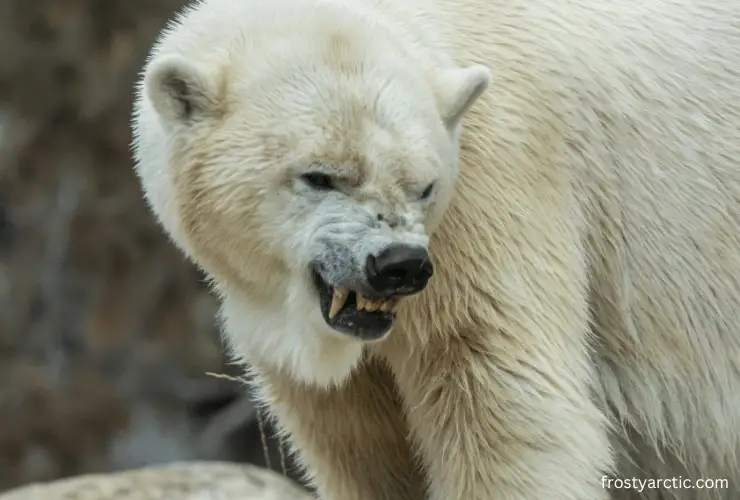
According to various studies on polar bears living in the Arctic in Eurasia and North America, the diet of polar bears is consistent between their various populations due to various factors. Here is a complete guide about what polar bears eat.
Seals, Seals, and Seals!
According to the study in the Journal of Mammalogy, polar bears have different diet plans in summers and winters. The authors reported:
Polar bears eat ringed seals and their cute pups in winter. Not just this, they also eat bearded seals, but mostly they like to eat ringed seals. Harp and Hooded seals are also not safe from polar bears.
Although these species of seals are less available, polar bears still manage to catch them from populations. Winter is a golden period for polar bears to catch seals without any risk. Ice plays the role of hunting ground for them.”
Fun Fact Time: Polar bears weighing 500 kilograms can spend their day with 1 kilogram of seal blubber. This is because seals are rich in energy. ~ Source
Polar bears are pro in shifting their diet. Most of the time, their diet is dependent on what is abundantly available. Let’s take an example from their real life. Polar bears’ main diet is bearded seals in the Hudson Bay area, but they instantly shift their diet plans to ringed seals. It happens because ringed seals are abundantly found in these areas.
Narwhals, Beluga Whales, and Walruses
The third main diet of polar bears after bearded and ringed seals are beluga whales. Narwhals and walruses come fourth and fifth in number, respectively. Almost half of the population of polar bears rely on beluga whales to add them to their primary diet.
All these animals are bigger mammals than polar bears, sometimes. But you know what polar bears managed to catch them and consume them with ease. Mostly, adult female polar bears and adult male polar bears like to hunt and eat beluga whales.
The approximate weight of a beluga whale is 1500 kg, while the approximate weight of seals is 65 to 300 kg. That’s why adult polar bears need more energy because adults are big and young. So, they require more fats and proteins to maintain their body weight.
Also, polar bears like to share these big animals with their groups. Obviously, a single polar bear cannot consume an extremely big mammal that weighs tons. Doesn’t it sound impossible?
Terrestrial Animals and Other Food Sources
In summer, when polar bears are strictly bound to stay on land, they eat terrestrial animals. For example, snow geese and caribou are their favorite secondary prey when the ice-free period starts. White bears are also seen while hunting fish.
As they are opportunistic predators, they also eat many other food sources. This may include marine algae, berries, and many types of plants like Lyme grass seed heads, herbs, and even shrubs. In summer, polar bears do fasting. It sounds strange, but they lower their metabolic rate.
Eating berries and plants can lower their energy levels in order to eat when foraging. Just like humans and other species of the bear family, they follow a diet plan of plant-based carbohydrates and terrestrial animals. In this way, their body weight lowers!
What Do Polar Bears Eat at Night?
According to a study by the National Wildlife Federation, polar bears are often engaged in nocturnal hunting behavior. However, they are considered crepuscular hunters. Yet, they are victimized while hunting at night, especially seals. From a logical point of view, nighttime is best for them to stay up and hunt seals.
Arctic Bears eat Whale carcasses, walruses, and seals at night. However, their feeding habits don’t significantly differ between day and night. They will definitely hunt whenever the opportunity arises.
Do Polar Bears Eat Other Polar Bears?

Yes! Recent research carried on by the Severtsov Institute of Ecology and Evolution by senior researcher Ilya Mordvintsev reported that polar bears eat other polar bears. Cannibalism is not their permanent behavior. They do this occasionally. Also, it is observed mainly in males. The study also reports that the rare occurrences of cannibalism are increasing.
CBS News also reports about the increasing rate of cannibalism in polar bears. According to the study by the SeaWorld organization, the only enemies of adult polar bears are other adult polar bears. They do not have any other predators except their fellow polar bears.
Do Polar Bears Eat Birds?
Yes, polar bears eat birds. They can even eat turkeys. Mostly, polar bears eat seabirds. According to one study, more than 90 percent of bird nests were robbed by polar bears in Greenland.
Polar bears also eat their eggs and chicks. They can eat geese, ducks, grouse, songbirds, hawks, chickens, eagles, owls, and many more. Not only do they eat live birds, but also scavenge on dead ones.
What Do the Polar Bear Cubs Eat? How do They Hunt?
According to the report of the SeaWorld organization, polar bear cubs depend on their mothers. They drink their mother’s milk when they are born. After a few weeks, they start moving with their mothers on the ice while lying down on their mothers’ backs.
When they are around 2 to 3 months old, they start eating their heritage diet – seal blubber. They grow so quickly on the meat and mother’s milk. They continue drinking their mother’s milk for at most 20 months. Thus, their mother’s successful hunt defines what they will eat in the Arctic.
What Do Polar Bears Drink? Do they Drink Water and Milk?
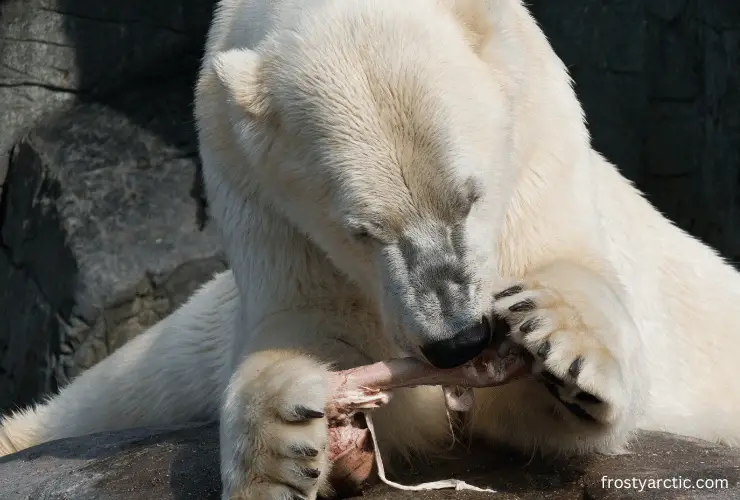
In a report on the Denver Water organization, the researchers state that polar bears drink water. They need water to live just like other living organisms. But, their way of getting water is different from ours.
Polar bears experience a special chemical reaction in their bodies. It then breaks into fats. In this way, they get water due to this reaction. According to an Indian Public Media report, polar bears eat snow and ice to get water but it’s sometimes expensive for them.
Their fat-rich bodies give them the benefits of getting water after chemical reactions. Another report at Polar Bears International states the Arctic water is salty. So, it’s not good for polar bears’ health. That’s why they don’t drink it but their metabolic chemical reactions save them from dehydration.
How Much do Polar Bears Eat?
An adult polar bear weighing 500 kilograms can eat steak blubber weighing only 1 kilogram. Polar bears require substantial energy intake due to their ability to burn more than 12,325 calories daily. In early summer, they can become extremely fat, having the same amount of fat as their lean body mass. For example, 1 kilogram of fat per 1 kilogram of lean body mass.
According to the research of the WWF Arctic Program, polar bears have a big appetite. If a polar bear weighs 100 kg, it can consume 10 to 11 kg of prey. However, they usually consume 1 to 2 kg of fats in a day. According to many other studies, they can eat 100 to 150 pounds of seal blubber in just one sitting.
How Do Polar Bears Get Their Food?
According to the Encyclopedia of Marine Mammals research paper, polar bears hunt. They get their food with their unique hunting techniques like “sit still” and “disguise diving“. They can easily catch a seal by pulling it out of the water just by sitting near the breathing holes in winter.
They have different hunting skills. For example, they use diving skills to hunt whales and walruses. Because these mammals do not come out of water. So, polar bears are after them in the water to hunt them in winter and summer.
Polar bears also use many other tactics to hunt birds and other marine mammals in summer. Mostly, they use similar tactics to other big carnivores to catch their prey. Their sharp claws are enough for them to catch slippery prey like fish and seals.
How Climate Change is Affecting the Polar Bears’ Diet?
For some reason, the climate is changing. So, it’s also affecting the diet of polar bears. The season of winter is becoming shorter and summers are longer than before. Polar bears are having difficulties in hunting their primary prey. The chances are they will start eating the same prey that other bears, like grizzly bears, eat.
Here are three scenarios that could result in upcoming years due to climate change:
- Polar bears will start eating what grizzly bears eat.
- Polar bears hybridization could result in grizzly bears.
- Polar bears will go extinct due to the lack of their primary diet deficiency.
So, the identity and population of polar bears are truly in danger. The reason is clearly global warming and climate change. Human activities are disturbing the ecosystem much more than before.
What are the Food Items that are Dangerous for Polar Bears?
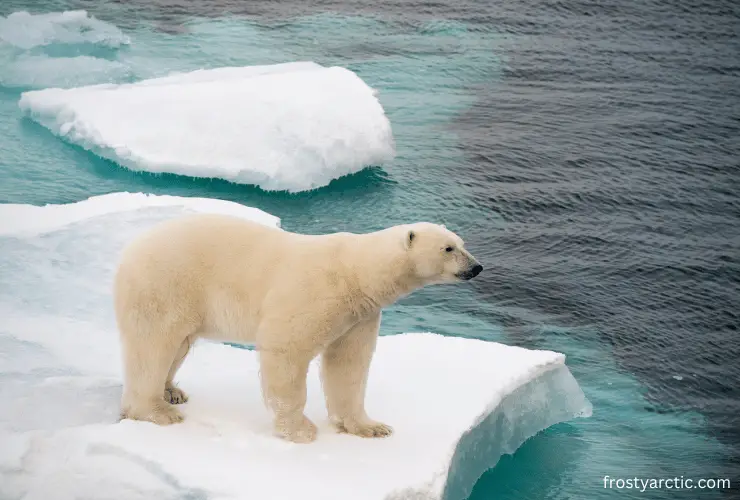
Here are a few food items that are dangerous for polar bears:
- Human food waste: Polar bears are attracted to human settlements and garbage dumps. They often consume contaminated or unhealthy food which is dangerous for them.
- Seal carcasses with high levels of pollutants: Consuming contaminated prey causes toxic effects on polar bears.
- Toxic plants and berries: Some vegetation in the Arctic are harmful to polar bears if ingested.
- Plastic and other non-biodegradable materials: Ingesting these items lead to digestive issues and health problems for polar bears.
FAQs’
Is it a polar bear consumer?
Yes, polar bears are consumers. They are included in the category of tertiary consumers. It means they consume other primary and secondary consumers. That’s another reason why they are known as top predators in the Arctic.
This is because they consume other mammals and even eat vegetables and fish. In fact, polar bears are designated at the top of the food chain.
Do polar bears like to eat?
Yes. Polar bears like to eat. They eat to survive and thrive in their life just like any other living organisms on Earth. And most demandingly, threat seals.
Do polar bears eat liver and heart?
Yup, polar bears do eat liver and heart. They love to eat the livers of sharks and seals. They get a lot of vitamin A from their livers but still do not get sick because they are genetically designed in this way. According to Richard Harris from the NPR organization, the various genetic traits of polar bears make them healthy.
Even after eating kilograms of blubber and livers of seals, polar bears stay healthy. And, they are totally fine with it.
Do polar bears eat the fur and feathers of birds?
No, polar bears do not eat the fur and feathers of birds. They eat bird meat. They tear them and get the meat out and eat. In case feathers and fur get into their stomach, they have a big stomach that can digest these little things. But, the main thing is fur and feathers are not significantly added to their diet. ~ Source
Do polar bears eat penguins?
No. Definitely not. Polar bears do not eat penguins. The reason is simple. They are living in totally different regions. Polar bears live in the Northern Hemisphere.
On the other hand, penguins are living in the Southern Hemisphere. The habitats of both animals are totally different. It shows polar bears can eat penguins in case they get a chance. ~ Source
What do polar bears eat if they live in a desert?
Polar bears do not live in deserts. They would not be able to survive in deserts because deserts do not give them seals and fish. Additionally, the harsh conditions of deserts would not be suitable for them to survive. The main fact is: the Arctic environment is just like barren areas that you can call the Arctic desert.
But, they would die if they lived in a place where there are no oceans“. However, if they live in deserts, for example, they will definitely try to catch any type of animal in the desert and eat their flesh to survive. They would not die without struggling for life. ~ Source
Wrapping – Up!
We have learned that polar bears are classified as carnivores as their primary diet consists of meat. In simple words, they are meat eaters. They also occasionally consume plant material or omnivorous items. However, their fundamental dietary preference and physiological adaptations align them with the carnivorous category within the animal kingdom.
More interestingly, they have an efficient digestive system that can absorb 97% of fats and 84% of the proteins that they eat. Also, they have enormous stomachs. Their stomachs can carry 10 to 20 percent of their whole body weight. It means their stomachs are so big that they can eat more than 2 kilograms of fat per day.
I hope all these facts about polar bears give us goosebumps and make you feel “WOW.



6 thoughts on “What Do Polar Bears Eat? Omni, Herbie Or Carni?”